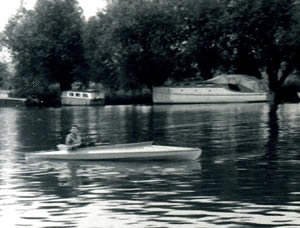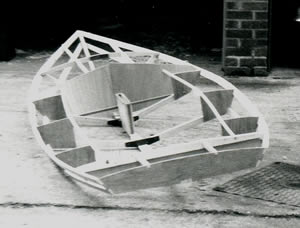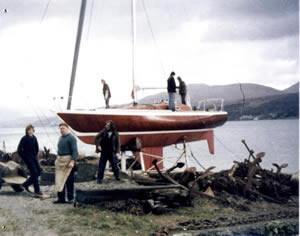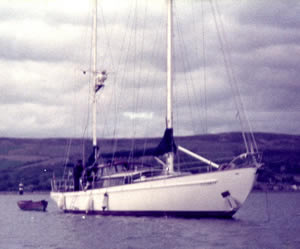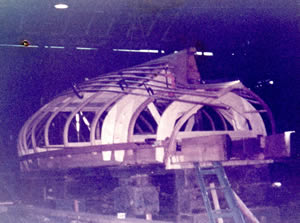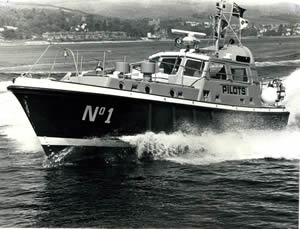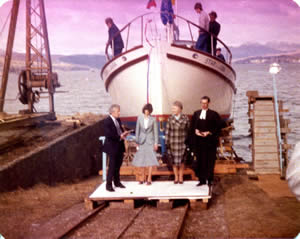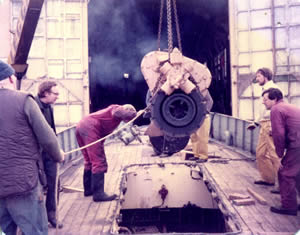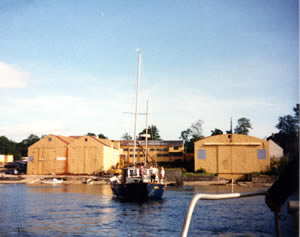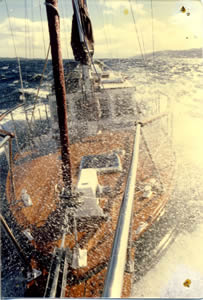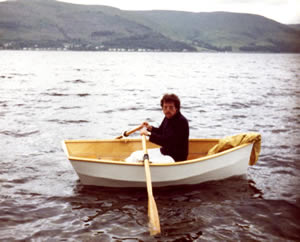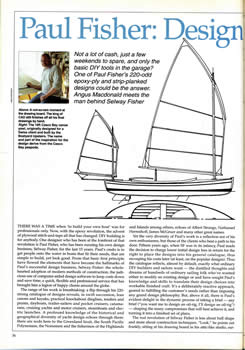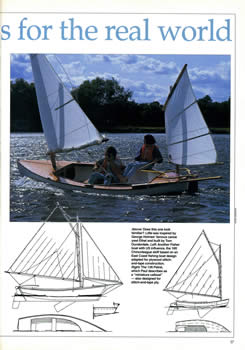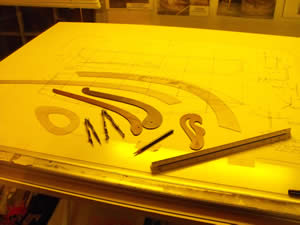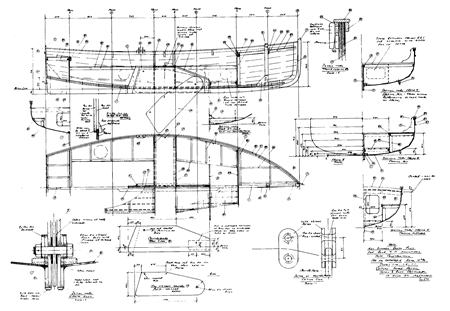|
|
|
A HISTORY OF SELWAY FISHER DESIGN |
(Last up-dated 23/01/09)
| How,
where and when did Selway Fisher Design start? Here is a short history
of the company and the philosophy behind the range of designs available.
The Beginning It all started with an intense boyhood interest in ships and boats, whilst l lived on the East Coast of the UK around Dovercourt and Harwich in the 1950's and 60's. Aged 11, my family moved from a seaside town inland, to a small town near Reading not far from the Thames and so, with the help of a school buddy, my interest settled on small boats rather than larger ships. Jim Curry, my school friend bought a succession of small boats whilst we were in our teens - these ranged from a simple sailing sharpie to a couple of converted lifeboats - as they got bigger (Artoo was a 28 footer) they got progressively more rotten and derelict - the future was always full of that "bigger boat" but funds never quite matched our dreams and so quality and the ability to keep the water where it should be (on the outside of the boat) deteriorated sharply. As school boy voyagers, we terrorized, with our awful attempts at boating, that piece of the river Thames that ran from Pangbourne to Marlow, centred on the Kennet Mouth Boatyard which consisted of a series of run down old shacks in the corner of land between a railway bridge, the Thames and the river Kennet (which runs into the K&A canal). Here, amongst a ramshackle array of broken boats being "converted", "repaired" and generally left to rot, we learnt from many ol' timers, the rudiments of caulking, laying a deck and the tricks involved in "keepin' the bleedin' water out!" These were halcyon days - we were young, with few cares and an ever growing interest in all things nautical - and for some reason, Reading Library was full of boating books - books on every type of conversion, books on boat building, design and maintenance and several by people like Uffa Fox, Illingworth, P.W. Blandford and Michael Verney - and we read and read and read - and because we couldn't afford to buy copies of the books, l copied great chunks of them into note books. Some-one gave us a whole load of old Yachting Monthlys and l spent hours pouring over the beautiful lines plans and construction drawings of designs they had published. I loved drawing and so l was inspired to buy some tech' drawing instruments and cartridge paper and start designing myself. At the same time l saved up and bought the kit from York Marinecraft for a PBK20 - a Percy Blandford designed double kayak - canvas over frame which l built at school (Woodley County Modern) under the inspiring tutelage of the woodwork master, Mr. Greenwell - everything gelled - the building side of the canoe, the repair and maintenance of Jim's boats and helping out the various weekend boat owners at the KMB - the books and finding a copy of Chapelle's "Yacht Designing and Planning" in a second hand book shop in Reading all led me to draw up my first design - a 14' "Ultra fast racing dinghy" - l started planning her aged 16 in 1969, finished the design work and then started building in 1970 - I did everything - made the wood mast and spars, bought in the sail cloth and hand stitched both sails - where l ran out of money (from my paper round) l used wood taken from old Utility furniture.
The hull was essentially 'V' bottom single chine and ply over frame with elements of stitch and tape. At this time l was studying for my A Levels at Forest Boys Grammar in Winnersh and was Commodore of the School sailing Club under the Sailing Master "Bummer Winch" - here is an excerpt from my book "A Slight Mist on the Horizon" (so far unpublished) -a novel based on my boating life to describe what happened - A
boat designer has to be a ‘jack’ of many trades - expert in hull
design to make sure the boat will carry all the weight imposed on it and
be efficient in her movement, sail design, sail control and ergonomics
for her fit-out are just some of the subjects a designer needs to have
an intimate knowledge of, if he is to design a successful boat. There
are so many more, but one very important subject, to which the good
designer must be well acquainted, is the strength of the different
materials used and the adequate design of the structure of the boat.
Now, Le Soliel was strong, or at least the hull was, but let’s
just say that there were certain inadequacies in the strength, or at
least, in my understanding of the need for strength, in certain small
areas of her construction. But l learnt. As usual - the hard way!
Le Soliel slipped, or shall we say, plonked into the water and
sat beautifully. My fellow crew mates from the school sailing club,
along with Bummer, carried her shoulder high from the borrowed trailer
with gusto and walked her down the slip and into the water, amidst a
profusion of comments. Some quite worrying. “I’m
sure the mast is too high, she’ll tip over easy!” and “I can see
those sails flying apart all over the place!” followed by “The
transom’s so shallow, she’ll ship water and sink!”
They were an encouraging lot, my chums, but she sat upright in
the water, with no apparent problems and with only the smallest of leaks
coming from around the centreboard case! “Look,
just a little trickle that! It’ll soon take up, gosh, she floats!”
That from Bummer, who was already downing some of his hooch in readiness
for the almost certain disaster to come. “So,
you’re actually going to sail her, Fisher!?” “Yup!” “Well,
good luck. Bonne
chance!!”
It would have been nice for the young Nichole to be there to
witness this brave first voyage. I wouldn’t have minded, if she had
been carrying her bébé and even had Napoleon yapping at my groin, but
l guess, she was back in France! Ah well, maybe some day she would read
of my sterling exploits in the French press and realise her mistaken
opportunity!
Willing hands soon raised the sails and Le Soliel immediately
took on the motion of a race horse, champing at the bit, impatient to be
let off the ropes holding her, so that she could fly over the waters of
the lake and hurdle over the waves. The wind was getting up and l had
sudden tremors of, not fear exactly but, a little trepidation, a slight
queezyness in the pit of my stomach. After all, here l was, after months
of planning and dreaming, sawing and screwing, about to test my very
first design, in full view of a slightly baying audience! “Go
on, get in and let’s see her go!”
Bummer crossed himself and raised his eyes to the heavens in
quiet supplication, followed by the bottle to his mouth! Ropey Haze
tugged at the straps on my lifejacket to make sure l was adequately
strapped into my only safety device and the remaining boys bore me up
and into the Le Soliel’s cockpit.
She was slippy, slidy and rocked with the need to get the wind
under her heels and go. The rudder was in place, the sheets ready, to
control the sails and without further ado, my ‘support crew’ pushed
me out into the lake, with a great heave.
Clear of the jetty Le Soliel wobbled alarmingly, whilst l fought
to get the centerboard down. It seemed to stick in the up position so l
drifted sideways towards the bank-side. The shore was covered in bracken
and creepers which l knew to have underwater roots that would ensnare
the unwitting and close by were overhead branches in profusion, just
right to entrap masts and rigging. Having spent many a lost afternoon
trying to untangle myself, or some unfortunate junior from that shore, l
wanted to keep well clear. I tacked the bow the other way hoping to gain
a short leg in the opposite direction. My throat was dry, but
fortunately, a kick to the top of the centerboard made it go down and Le
Soliel immediately responded. And a tweak to the rudder and a push down
on it’s blade sent us forward in the direction l had pointed her,
allowing us to get away from my waiting observers and the tangled bank.
Le Soliel started to respond as she was designed to do and clear
of the little inlet that led from the jetty, l tacked out and into the
lake proper. Water creamed from her bow and l experienced the
indescribable thrill of sailing forward in a boat of my own creation. I
settled back as we raced forward. There were a few ominous creaks from
various parts of the hull and rigging, but nothing seemed to want to
actually give way and so l tacked again, to get further into the lake.
Soon, l was able to turn a corner in the bank and put her on the
fastest point of sailing, a broad reach, with the wind coming from just
aft of the beam.
She was fast. Very fast, and responded like a thoroughbred,
surging forward and, l swear, starting to surf onto her bow wave and
plane. Cheers came from my crew mates mixed with Bummer’s hearty deep
guttural roars of appreciation and l guess, relief! I disappeared
towards the opposite bank of the lake in a welter of spray.
My school mates later told me, after l had been recovered, that
Le Soliel and myself were traveling at a fair rate of knots and looked
‘real great’ as we were enveloped in spray ‘flying all over the
place’! But this was little comfort, having had to swim, choke and
finally walk away from what happened!
The further lake side emerged quickly into view and l had to make
a turn. Before l could do so my attention was taken by seeing the screws
holding the lower mainsheet block to the hull, start to pull out under
the enormous tension of having to control the massive area of the
mainsail. Then, to my horror, l could see that the back piece of the
mast, which had been glued together out of four pieces of knotty Pine to
make it light and hollow, started to part from it’s neighbours, just
above where the boom attached to the mast!
This was all recoverable, if l could just let the sail out, spill
the wind and turn her round. I could then drop the sails and paddle back
to the jetty to effect some repairs – fine, if l had had a paddle!
But this was not to be. l got it all arse about face! Stupidly l
used the rudder to turn the boat, before taking some of the pressure off
the mainsail, by letting out the sheet and reducing her speed. Le Soliel
started to turn. At speed. No problem. Until the pressure on the rudder
snapped the rudder blade clean off with a massive crack, leaving me with
no steering control! The released part of the blade shot into the air
and spun back to float uselessly in my wake! “Bugger!!”
I can remember thinking, as Le Soliel started a fast twist and
eventual catastrophic capsize, that l now realized why the wood grain on
the rudder blade should run along the length of the blade and not across
it! Unfortunately, the only way l could cut it from the old wardrobe
door l had used, was to have the grain horizontal and this was a major
weakness. With the blade now detached and floating somewhere astern of
us, Le Soliel did the only thing a sprightly lady of her sort could do,
once allowed out of control, she deposited me into the water and turned
completely upside down, the shards of her knotty Pine mast sticking
firmly into the lake bed!
I doggy paddled, choking to the edge of the lake, but strangely
happy! My creation, now looking like some water feature gone very wrong,
stood before me, a monument to my lack of structural knowledge and,
perhaps, to my lack of adequate funds. But, l had succeeded. I had
designed a boat in my mind, drawn it down, planned it’s construction
every step of the way and built it. And having launched her, she had not
only floated the right way up but, with her homemade sails, had actually
worked. Not for long mind! But she had sailed forward and had shown
great potential. I was a boat designer and not out of my teens yet!
Jim and l parted company - he went to art school in Bristol (and eventually lived on a succession of boats including a Mounts Bay Lugger around Millbrook near Plymouth) and l went to the University of Newcastle upon Tyne to study Naval Architecture & Shipbuilding - from 1971 until 1974 when l graduated. My small boat interests were somewhat curtailed by the study of super tankers, warships etc although l managed to design a succession of large yachts in my private time and design a National 12 for a fellow student ending up doing a comparison of various different construction methods for 1/4 Ton rated racing yachts for my final year thesis. |
| The Start of
Professional Yacht Design Work
At University, l got married to Dilys and following my graduation l managed to get a job as a Naval Architect with McGruer & Co. of Clynder on the Gareloch in Scotland. The learning curve had been quite steep with my previous boating activities on the Thames, and the South and East Coast but it now took off like a rocket! McGruers were famous (since 1897) for the design and construction of bespoke racing and cruising wood yachts - l was lucky, l worked under both George and, before he retired, James McGruer. The drawing office consisted of myself, John Howard and the chief Naval Architect, Dennis Davidson - we had a fairly close community of designers near us - Ian Nicholson was a regular visitor to the office, we had G.L. Watson, Murray Cormack Assoc. etc and apart from building yachts to their own design, McGruers (www.mcgruer-boats.co.uk) also built yachts to the designs of Sparkman & Stevens, Peter Norlin, Dick Carter etc - the office was crammed with half models, drawings and copies of the Rudder magazine going back to the 19th Century - there was a loft full of experimental models and the Yard was traditional having it's own loft floor (run by David McGruer), engineering and steel work shop, boat builders/boat joiners shop, rigging shop and paint shop.
My 3 years there were crammed with experience - one day l could be working on the drawings for the fitting of a new galley and chart area for an 8metre cruiser racer - the next helping loft the lines full-size of an Admiral's Cupper or working on the proposal drawings for a new Ocean Cruiser - or out on the Gareloch taking a new Pilot Cutter onto the measured mile for speed trials - it was a wonderful, time working with great people.
During this period, despite spending a lot of my spare time racing on the Clyde (crewing on Ninian Sanderson's 3/4 tonner "Nippie Sweetie" or with Staveley Roberts on his Dragon "Crackerjack" etc etc) and sailing the West Coast of Scotland, l dreamt of the sort of boat l wanted to build for myself - it was during this time that the Grey Swan and Tideway 14 designs were born - influences being taken from all sorts of craft wintering in McGruer's sheds. Yachts would come and go like beautiful and intriguing women to catch the eye - at one time we had "Saunterer" Titus Oates' old boat in the yard which l worked on to change the keel shape forward to stop her from "gripping" to windward - and several Fife designs.
I left McGruers in 1978 and walked just half a mile up the road to Silvers - famous for wood motor yachts - unfortunately the company name was changed to D.M. Russell Marine, but the workforce was much the same as it had been in the late Silvers era - l worked 5 years here on various motor sailers and fit-out jobs with Dougie Haig, Tommy Davidson, Ian Connell etc.
A mixed bag of sailing experiences - middle distance races and sailing with the late great Peter Hayward on yacht deliveries occurred during this period and at home, having sold one hull of a James Wharram Hinemoa which l never finished, l started my own design work in earnest - the Highlander range was born due to the need of several sailing friends requiring lightweight, easily built dinghies. I experimented with the epoxies coming in from the US from WEST, developing the hull panels shapes by first drawing the lines and from this making a wood half model and then carefully tracing off this model, the separate hull panel shapes - using these to make a simple card model and then making adjustments before transferring the shapes full-size to the plywood.
I made lightweight ply/epoxy masts and Dilys and l built the first Micro 18 - the North Pacific 60 was drawn up and the initial sketches for several pocket cruisers which eventually made their way into the SFDesign catalogue were worked on. At Silvers (D.M. Russell Marine) most of the work involved fitting out grp hulls - G.L. Watson motor sailers, John Bennett yachts and a Murray Cormack pilot cutter along with repair refit work for the RNLI and the conversion of one of the old Erskine chain ferrys into a restaurant barge.
We moved South to Devon in 1982 with our daughter Katie and I started Selway Fisher Design - designing and building the range of Highlanders but, we were into recession and having undertaken a series of lectures at the James Watt College on various aspects of yacht design when we lived in Scotland, which l enjoyed immensely, l studied for a Post Graduate in Education and taught Design/Technology for a while - but Selway Fisher continued with small commissions. I did voluntary work at the Exeter Maritime Museum under Major David Goddard who had traveled extensively in the Far East collecting wonderfully obscure native fishing craft - the collection included a Junk and a Dhow - craft of every description and the deal was, that if you worked maintaining them during the winter, you could sail them during the summer. I took the lines off several boats - a Sunderland Foy Boat, an East Coast Fishing Smack and several others and examined the construction methods used throughout the world.
Where did the Selway come from? - well, you know how it is, my lovely wife's maiden name is Selway and she has a brother who, at one time, we thought, may not settle down and produce a family and so we decided to incorporate the name - as it happens, he did settle down and produced a son! - but the name stuck. |
| The Philosophy Behind
Selway Fisher Design
I had been privileged to work for 2 companies at a time when wood boat building was still a major part of the overall boat building output - this meant that there were l worked on boats designed specifically for one individual, which meant that there was plenty of design work. The advent of grp boat production meant that many boats could be taken from one design/set of mould tools and instead of the long list of designers and prolific number of individual new designs being built that once existed, we now had a process where there were as many new boats as previously, but to fewer individual designs. Latterly McGruers and D.M. Russell Marine tried to buck the trend to a certain extent by offering "individual and bespoke" fit-outs on standard grp mouldings but the era of the Yachting World year books which described the many new individual designs launched during a particular year had come to an end - not just because of grp but also because the Teaks etc that we used were no longer available in large high quality boards and the career of traditional boat building was no longer attracting young school leavers. The philosophy behind Selway Fisher Design was and still is, to offer individual design to boat enthusiasts - to enhance the wide range of designs available and to buck the trend of having to take what is on offer "from the shelf". But design fees are not cheap, so how do you offer such a service and at the same time, "keep the wolf from the door"? The answer came in the form of new technology - epoxies as coatings and then as glues were part of the answer - and personal computers and yacht design software were the other part. When l was asked to design the Highlander 16 in the late 1980's it took two days to draw up the initial lines and to do very basic hydrostatic calculations (Volume of displacement/rough mass calculation, Longitudinal Centre of Buoyancy and Prismatic Coefficient) - another 2 days to carve the half model carefully to match the initial lines and to take off the hull panel shapes using tracing paper - another day to make a simple card model and check this against the initial lines and then another day to develop, using a scale ruler, the final hull panel shapes - a weeks work at least! Doing individual stitch and tape designs was a long process with no real idea how it was all going to go together until the full size boat was built - in this case on the other side of the world in New Zealand! In 1990, l twisted the arm of my bank manager who new nothing about boats but who was very supportive, to loan me the money to purchase a PC and the software l needed. This allowed me to model the hull in half an hour, do a full hydrostatic check in seconds, go back to the model and make any changes, recheck the hydrostatics and then fair the hull and produce very accurate hull panel shapes at the touch of a button in seconds - and Selway Fisher Design really took off!
|
||||
| The Drawings and How I
Work
In McGruers, we worked on large flat drawing desks - this was all pre-computer (or even calculator) and so all drawing work was done by hand using splines (battens) - long thin and tapered pieces of wood (often Mahogany or box wood) held in place for the curves by lead weights (ducks). For the tighter curves on lines plans etc, we used yacht curves. There was craft in working like this and being able to step back from the drawing board allowed a wider perspective of the design - something l think, that gets missed with modern computer screen work. For my own satisfaction, l keep as much of the craft in the process as l can - l know it's not the modern way and it means that drawings are not easily stored on hard drives, but l prefer to produce the finished drawings by hand in the old way. i use the computer and YachtCAD software to do a specific job very efficiently - so the hull modeling, hydrostatics, mould or frame and hull plank/panel shapes are all developed on the computer - after that l work by hand but using data from the computer - it's a nice way to work.
|

